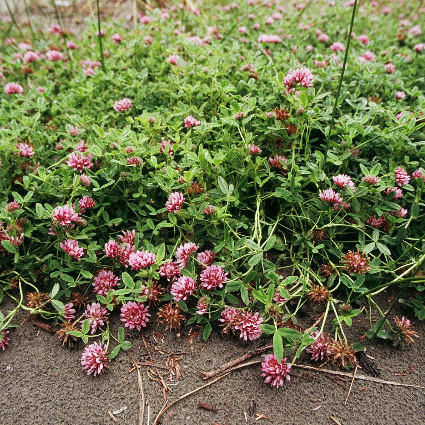Springbank Clover
Trifolium wormskioldii Lehm.

overview
Perennial herb with creeping rhizome. Stems are branched, prostrate, to 30 cm long, tips turning up. Leaves are compound, three-foliate; leaflets to 3 cm long, pointed at tip and finely toothed. Flowers are red to purple, often tipped with white, pea-like, to 1.2 cm long, in dense heads of 2-60 flowers to 3 cm across. Pods with 1-4 seeds (Pojar and MacKinnon, 1994). Photo by Toni Corelli.
family
Fabaceae
ecological setting
Moist to wet, open places from low to middle elevations. Often found growing together with pacific silverweed in dense patches along estuaries (Pojar and MacKinnon, 1994)
soil texture
Medium textured soils (Kartesz, 2006)
nutrients
Rich (Klinkenberg, 2004)
soil reaction salinity
pH 6.2 – 7 (Kartesz, 2006)
moisture regime
Medium (Kartesz, 2006)
shade tolerance
Intermediate (Kartesz, 2006)
bec zone subzone status
CWH, CDF (Kartesz, 2006)
site rehabilitation
Roots contain nitrogen-fixing bacteria. Some of the nitrogen is used by the growing plant but some can also be used by plants growing nearby (Kartesz, 2006).
wildlife
Geese are known to eat the roots of Springbank clover (Turner, 2004).
landscaping
Potential ornamental
first nations
The long, fleshy white rhizomes were an important food source to northwest coast peoples (Pojar and MacKinnon, 1994).
other uses
Can be used as fodder for animals (Kartesz, 2006).
flowering time
Late spring
fruit ripening time
Summer
seed collection time
Fall
crop intervals
Normally perennial
no seeds per kg
343,000
seed viability
Medium
collection and abstraction
The best time to collect seed is in the fall as the flowers are starting to dry out and die back (Turner, 2005). Best to collect on a sunny day if possible so that the seeds are already dry.
seed storage
Dry seeds (without heat) and store in sealed paper envelopes (Turner, 2005).
fruit seed dormancy treatment
additional info and photos
For more information and pictures, visit the E-Flora BC website at www.eflora.bc.ca.www.eflora.bc.ca